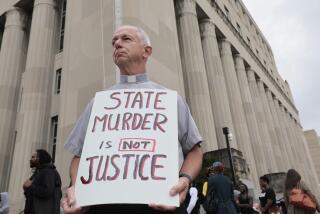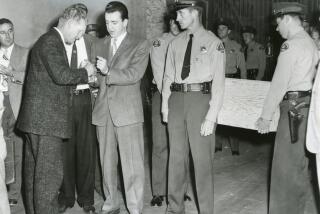Op-Ed: Bias in the justice system is real, and the death penalty reveals it
When Gov. Gavin Newsom suspended the death penalty in California last week, he cited an “ineffective, irreversible and immoral” process that, from trial to execution, is tainted by racial discrimination.
African Americans bear the brunt of the bigotry; they’re the most overrepresented on death row. In a state that is only 6% black, more than one-third of defendants sentenced to death in California are black. Decades of studies have uncovered ways that race can tip the scales. For example, in capital cases where the victim is white, defendants are significantly more likely to receive a death sentence than when the victim is black.
But the truth is more complicated, and more insidious, than a simple black/white divide. When black men are judged by juries in capital cases, their sentences can hinge on just how black they are perceived to be. Those with darker skin, wider noses and thicker lips are subject to far harsher sentencing than lighter-skinned blacks with less prominent, so-called black features.
In research I led in 2006, looking “more black” more than doubled the chances that a defendant would receive the death penalty. But only when the victims were white.
When the implicit narrative of black “wickedness” is not challenged, it can seem to perfectly explain the disparities in outcomes.
To determine the impact of appearance on jurors’ decisions, my team of psychologists and legal scholars used a database of death-eligible defendants — black men convicted of capital crimes committed in Philadelphia between 1979 and 1999.
We showed the mugshots of those defendants to a group of people who had no idea what our study was about, and asked them to rate each photograph on how “stereotypically black” the face appeared. We told the raters they could use any number of factors to make their determinations, including skin color, facial features and hair texture.
Then we applied their ratings to the individual cases and examined the sentences those defendants had received at trial. For black men convicted of killing black victims, there was no “stereotypicality effect.” The men whose faces were rated “highly stereotypical” were sentenced to death at exactly the same rate as those who were rated low in stereotypicality.
However, when we looked at black defendants who were convicted of killing white victims, we found a huge effect. Of the men rated low in stereotypical features, only 24% had been sentenced to death. But more than 57% of the “highly stereotypical” black defendants were sentenced to die for their crimes.
The difference persisted even when we controlled for factors like the severity of the crime, aggravating or mitigating circumstances, the defendant’s socioeconomic class and the defendant’s perceived attractiveness. Regardless of the nonracial factors we took into account, black defendants appeared to be punished in proportion to the blackness of their physical features, the closer they hewed to conventional stereotypes.
Those strong distinctions signal that our perspectives, our criminal justice process and our institutions are influenced by primitive racial narratives that link people of African descent to darkness and evil.
The 18th century philosopher Immanuel Kant once asserted that “punishment should be pronounced over all criminals, proportionate to their internal wickedness.” Even in the 21st century, when people look upon a black defendant who is eligible for death, they may use the “blackness” of his appearance as a marker for wickedness and attempt to punish accordingly.
Our deepening knowledge of implicit bias has contributed to 20 states abolishing the death penalty. California’s moratorium, however, will expire when Newsom leaves office, unless he can woo voters to his cause. Ironically, he may have made that harder by citing racial discrimination in his decision. Research has shown that highlighting racial differences in the justice system actually leads members of the broader public to be more supportive of punitive policies, including the death penalty. When the implicit narrative of black “wickedness” is not challenged, it can seem to perfectly explain the disparities in outcomes.
Concessions to bias and bigotry have been so thoroughly incorporated into our national perspective on fairness and liberty that they have proven especially stubborn to change. Even documentation of gross racial disparities failed to move the Supreme Court in a 1987 death penalty case that has been called “the Dred Scott decision of our time.”
Enter the Fray: First takes on the news of the minute »
After reviewing research that included 2,500 Georgia cases, the court acknowledged “a discrepancy [in sentencing] that appears to correlate with race.” Still, the justices upheld the death penalty for Warren McCleskey, a black Georgia man convicted of killing a white police officer while robbing a furniture store.
Justice Lewis Powell, writing for the five-member majority, dismissed the statistical evidence because, as he put it, “disparities in sentencing are an inevitable part of our criminal justice system.” He worried that ruling otherwise would open the door to discrimination claims related to all manner of “arbitrary” variables, “even to gender,” he wrote. Or to “the defendant’s facial characteristics.”
The ruling came under heavy criticism from legal scholars and civil rights activists, concerned that it made institutional racial bias constitutional, and simply part of the status quo. Powell’s decision reverberates today, making it difficult to challenge racial bias in any phase of the justice system without proof of deliberate discriminatory intent.
Two months after delivering the ruling in the McCleskey case, Powell retired from the Supreme Court. He would later say that his decision in this case — which allowed McCleskey’s execution to go forward, in 1991 — was the only court ruling he participated in that he ever regretted.
Jennifer L. Eberhardt is the author of “Biased: Uncovering the Hidden Prejudice That Shapes What We See, Think, and Do.” She is a professor of psychology at Stanford University, and is a co-founder of SPARQ, which brings together researchers and practitioners to address significant social problems.
Follow the Opinion section on Twitter @latimesopinionand Facebook
More to Read
A cure for the common opinion
Get thought-provoking perspectives with our weekly newsletter.
You may occasionally receive promotional content from the Los Angeles Times.










